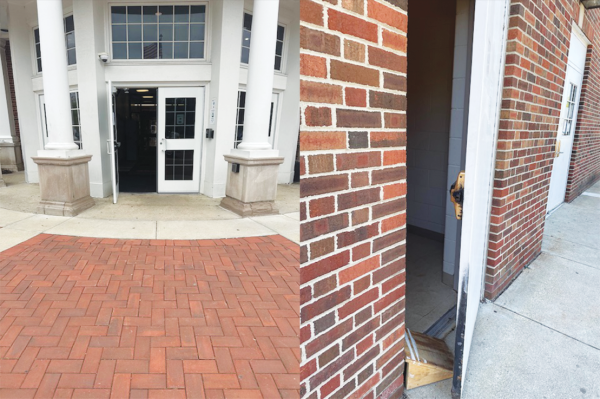SLO Tests Wreak Unnecessary Havoc
It has finally happened. The focus of school is no longer on the learning, but instead based on how well students can perform on a test. We knew it was inevitable with the long lasting Ohio Achievement Assessments, and the months and months of preparation leading up to them, but we never thought it would come to this.
The new state mandated SLO tests have been implemented in high schools statewide. You all may recall the day at the start of the school year when your teachers apologized as they passed a test out to you, essentially advising you to fail. This is because teachers didn’t want to give the test any more than you wanted to take it.
Like most teachers, history teacher Kyle Fleming feels the pinch to get through all of the required material. “I think everyone feels rushed to complete the curriculum, but really in history we do because if you think about it logically, history keeps happening but we don’t get more days in the year,” Fleming said. “So I mean, you’re always going to be in a rush, and especially now because the SLO’s are taking a day here and at the end of the year.”
The SLO tests, or Student Learning Objectives tests, are taken in all classes at both the beginning and end of the year to monitor student learning. They’re now required across the state of Ohio in all public schools. In each class we sat through the first round of these tests, and will do so again come April. But if these tests don’t count for a grade, why take them? Because 50% of our teachers’ evaluations by the state will be graded on our performance.
“You cannot measure how good a teacher is based on how well a student performs because there are so many different factors that determine how a student is going to do,” Biology teacher Nathaniel Hsu said . “Not even in terms of their own ability, but in terms of their own environment. Things beyond the control of a teacher or a school.”
Not only are the SLO tests a burden to our teachers, but have also affected the way they run their class. History teacher Elizabeth Plautz feels she has not been able to teach to her best ability because of the SLOs.
“We had a very quick turnaround time after we submitted the SLO and got it back for revision. So because of that, and adapting to the overall new teacher evaluation system, plus everything else that’s going on in this building at the beginning of this year, I know that my classroom has not run the way I would like it, that my attention has been divided,” Plautz said.
Although SLO tests are made to measure our growth in a certain subject over the course of the year, there are other ways to achieve this goal without wasting the school’s time, money, and resources, many of which are more effective.
“I feel like they’re already telling teachers something that is a little obvious; most people aren’t going to know the material at the beginning of the year and by the end we will hopefully know a substantial amount of that material,” sophomore Jonah Ricannati said.
By reinforcing this common knowledge, the SLO tests have violated our learning environment. It created a toxic vibe in classrooms at the very beginning of the year, causing both teachers and students unnecessary stress and anger.
“The way it’s being implemented in the state of Ohio at the high school level is ridiculous, but I understand the intent behind it and I think it’s a good effort,” Plautz stated.
This is the first year that the SLO tests were implemented in Ohio schools. The purpose of these tests are to track the annual growth of students in each and every one of their classes, because, in the state of Ohio’s mind, the knowledge we learn can be measured by just two short assessments.
“Students are humans, they’re not data points. Some of their learning can be quantified, but not all of it,” Plautz said.
It’s hard to say if the state actually thinks that attempting to measure growth over a year will in any way be efficient, or if they just had no other plausible ideas. It seems these days the American Education System has adopted a new slogan: when in doubt, implement another standardized test. Because apparently, that solves all of our problems.
We have all grown up with standardized tests. They were a large part of our elementary school years, as we grew up taking the OAAs. But let’s not forget when the state changed the name of the test from Ohio Achievement Test to Ohio Achievement Assessment, because apparently, the word “test” is far scarier than the word “assessment.” And students’ testing performance obviously skyrocketed once the name of the test, excuse me assessment, was made less intimidating, right?
Because these tests have been in place for so long, the state must be getting some kind of results that they like to see. Still, it doesn’t make up for the fact that not all students fit the mold of standardized testing.
“I think that they [standardized tests] really can’t truly be standard because everyone has different experiences. I think there’s more meaningful ways to assess students,” Fleming said. “I can understand where standardization is a tool that can be used to compare between states, between countries, whatever, but there’s more meaningful ways. And if you think about playing the odds, if it’s a standardized test of multiple choice, there’s a 25% chance you still don’t know what you answered but you got it right because you guessed well. So compared to essays and things of that nature, they definitely have their shortcomings.”
Different students have different styles of learning. Standardized tests work with some learning styles, but clash with others. Is it fair to measure students in a “standard” way when their learning is not standard at all? Students who are more of kinesthetic learners, or perform better on essays then multiple choice, are slighted and perceived as less intelligent than the student who can ace a multiple choice test. We admit, it is hard to find one type of assessment that can fit everyone’s style, but is it fair to constantly cater to one type of learning?
While standardized tests seem to be the long lasting norm for high school students today, they are a relatively recent addition to schools. Today’s politicians grew up in the far off land where state mandated testing was a thing well into the future, and they seemed to have turned out fine, with the exception of thinking that standardized tests can measure knowledge. The world revolved without standardized tests, students still learned, and they were still able to get into college without the need for a test score to represent them.
If students, teachers, and the education system were able to function before standardized tests, why the sudden need to create and mandate all of the recent additions?
“Kind of like the SLO itself, it’s a necessary evil,” Hsu explained. “It’s the easier way to go about it. There’s too much manpower and resources required to accurately assess a student’s performance, much less a teacher’s performance, so they come up with a quick, dirty way of doing it, which is a standardized test.”
Standardized tests were originally used for universities to make sure students were able to handle college-level work. After their emergence in 1901, the world of standardized testing took off. They’ve now morphed into a definition of our generation. It shapes how we view the world, and how we view ourselves.
However, no matter how much we try not to get down on ourselves about a test score, it can be hard. It seems that when we return to school each fall for a fresh start, there is always some new state mandated testing policy. With the load of stress intensifying each year, we wonder if it will ever stop.
A recent survey conducted by the American Psychological Association found that nearly half of all teens, a total 45 percent, said that they were stressed by school pressures. Undoubtedly, majority of this anxiety is caused by the insane amount of pressure we feel to ace every standardized test thrown at us, and the frustration we feel if we don’t. But the sad reality is that not all people are meant to be standardized test takers. According to Sophomore Jonah Ricanati, the anxiety and stress can affect students’ testing performance.
“Some people definitely test better than other people, and some people who have anxiety from testing might let that get in the way of what they really know about the subject that’s being tested,” Ricanati said.
From what it looks like, these tests are here to stay. Going forward, we can only hope the state will find a better way to manage the new testing takeover.




